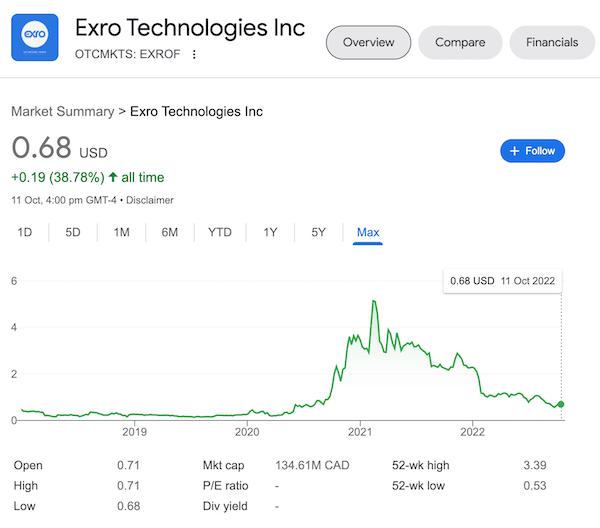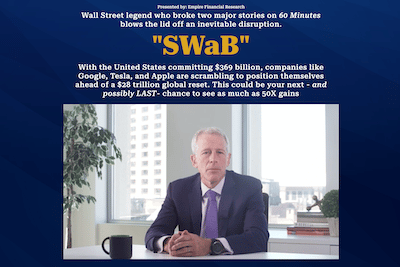Today I’m looking into an Alex Koyfman pitch that centers around a “tiny tech startup” based in Canada, which he says has created a “revolutionary new motor” that supposedly makes every existing electric motor “a relic.”
Koyfman essentially argues that this company’s tech is the next evolution in electric motors and says he thinks it “should see a 1,000-fold gain” in five-to-ten years.
“This is the first and probably the only time in my entire career that I can legitimately say this company should see a 1,000-fold gain within the next five–10 years.”
Source: https://secure2.angelpub.com/o/web/428543
That’s a pretty hyperbolic claim, to say the least.
But I was curious to know what company he was talking about as I’ve seen this pitch pop up from time to time over the past several months. So I looked into his clues to see what I could find, and I’ll show you everything I uncovered in this post.
A Solution to a “Fatal Flaw” In Electric Motors?
The gist of Alex Koyfman’s pitch is that there’s a “fatal flaw” “at the core of every Tesla car,” which he later reveals is the electric motor.
Based on what he says in the presentation, however, Koyfman is not specifically talking about there being a flaw in Tesla’s motors.
Instead, he’s talking about a flaw in electric motors in general.
“You see, at the core of every Tesla car lies a fatal flaw.
“It’s not the fault of the engineers. It’s not the fault of Elon Musk. It’s not the fault of the electric car industry.
“This fatal flaw is much bigger and farther reaching than Tesla itself. It affects billions of devices around the world, from tiny ones like the phone in your pocket to the electric watch on your wrist and all the way up to oil tankers weighing in at half a million tons.
“That flaw is the electric motor.
“You see, since they were first invented back in the 19th century by British scientist Michael Faraday, electric motors have had a weakness built into them.
“Incredibly, that weakness has never been addressed.”
What “flaw” or “weakness” is Koyfman talking about?
I’m not an electrical engineer or expert on how electric motors work by any stretch of the imagination, but my understanding of what Koyfman’s saying is that the company he’s teasing has developed a way to make electric motors more efficient.
Koyfman argues that electric generators and motors work at “peak efficiency” in a narrow speed and torque range, which limits their efficiency.
And to explain this concept, he used the example of a bike.
Basically, Koyfman talked about how bicycles became more efficient with the introduction of gears and said that electric motors have “never had this sort of internal mechanism,” suggesting that this is what has made them less efficient than they could be.
Here’s how he puts it:
“Electric generators and motors work at peak efficiency in a narrow speed and torque range. And that limits their abilities to convert energy or produce electricity efficiently as speed varies.
“This results in great energy losses in all applications, most notably: Wind power generation, electric cars and mass transit vehicles, run-of-river generation, mining operations, etc…
“It’s actually pretty easy to understand if you compare it to a bicycle.
“To get maximum usability, modern bicycles have several gears to allow you to use your leg muscles most efficiently as you go faster or slower, uphill or downhill.
“Electric motors never had this sort of internal mechanism.
“It was always just a single spool of wire that carried a single voltage.”
How does this relate to the company he’s teasing?
In short, Koyfman claims that the company he’s teasing was the first to “build a gearing system into the spool itself” using “highly sophisticated algorithms,” which is apparently part of a system called “dynamic power management” (DPM).
“What this company did, that no company before it has ever been able to do, is build a gearing system into the spool itself.
“Only, it’s not mechanical like the kind you’d find on a bike or inside the gearbox of your car.
“It’s done using complex, highly sophisticated algorithms to optimize power electronics and efficiency at all speeds.
“The system is called “dynamic power management” (DPM). And today, it’s giving the same kind of advantage to a whole new generation of electric motors and generators.
“It’s the same kind of advantage that a 10-speed bike would have over a primitive bike from the 1800s or a child’s tricycle:
“It’s that simple and that dramatic of an improvement.
“It’s maximum efficiency at any speed.
“And it’s a single invention that within the next five–10 years will make every existing electric motor and power generator obsolete.”
So, that’s the gist of Alex Koyfman’s pitch… he’s basically saying that the company has come up with a way to make electric motors better and more efficient.
And as for what specific company he’s referring to, let’s take a closer look at the clues.
De-teasing Koyfman’s Electric Motor Pick
Based on what we’ve already discussed, we know that Koyfman is teasing a Canadian company that is working on a system called dynamic power management.
Aside from that, he shared a couple of other main clues.
First, he said that its market cap is $20 million:
“This innovator, which now controls patents to the first true evolution of the electric motor, is a true-to-life technology startup with a total market capitalization of less than $20 million.”
As I’ll explain shortly, that clue appears to be outdated. But it does tell us that the company we’re looking for is “tiny” in terms of its market cap.
And the second main clue he shared relates to a partnership the company has entered into with another company to integrate its tech into EV car conversions, wind turbines, and trams. Here’s a summary of that clue:
“This past spring, the company inked a partnership deal with a major North American electric motor and generator producer.
“The partner is a heavy hitter that manufactures motors and generators for a wide variety of industrial and commercial applications.”
[…]
“Three existing product lines will be getting retrofitted with our company’s dynamic power management technology, each representing a significant foothold in a multibillion-dollar market…
“The first focus will be on electric motors that the partner company currently manufactures for its car conversion kits.”
[…]
“The second focus will be on small wind turbines.”
[…]
“The third focus is on electric trams and high-speed trains.”
That last clue made solving this a sinch.
All I did was Google dynamic power management technology for electric motors and came across this article on the exro.com website, which shows that the company behind this tech is Exro Technologies Inc. (EXRO.TO or EXROF).
Then, I looked into what companies have partnered with Exro, at which point I came across a 2018 article on eqs-news.com talking about an “industrial collaboration agreement with Potencia Industrial” that involves three projects.
One project relates to an electric motor for a car conversion kit, a generator for a small wind turbine, and electric motors used in trams and trains.
According to the above article, the deal centered around integrating Exro’s DPM technology into Potencia motors and generators with the goal of “improving various aspects of motor/generator performance.”
So, that matches Koyfman’s “partnership deal” clue.
What about the other clues?
As mentioned earlier, one of Koyfman’s clues was that the company had a $20 million market cap. And as of writing, Exro has a market cap of over $134 million Canadian dollars (less in USD).
This initially threw me off, but it seems as though Koyfman’s pitch may have been originally released in 2018 and updated in 2020 (based on what he said in the presentation).
I can’t be sure of this since Angel Publishing, the company behind this, never date stamps their presentations (which is super annoying). But that’s what it looks like.
In any case, according to the company website, Exro was publicly listed on the Canadian Securities Exchange in 2017. And the share price is much higher now (October 2022) than it was when it was listed and during the first couple of years it traded.

In any case, based on the clues, Exro appears to be Koyfman’s pick.
And the innovation Koyfman was referring to in the presentation appears to be the company’s Coil Driver™ technology. I can’t be 100% certain about this, but based on what he said in the pitch and how the company website described this tech, that’s my guess.
Here’s a snippet from the company site about its tech:
“Exro has developed a new dynamic controller, the smart Coil Driver™, that replaces the standard controller of an electric motor. This controller effectively creates an intelligent electronic gearbox inside the motor.”
Source: https://www.exro.com/technology/coil-driver
How can you find out more?
If you want to learn more about the company’s tech, the links I shared earlier might help. But other than this 2021 article by Simply Wall Street on Yahoo Finance, I wasn’t able to find much online about this company from an investment standpoint.
You could also see Koyfman’s research report. Specifically, the one called “Electrified Profits: From Startup to Trillion-Dollar Industry Giant.” You’d need to join his Microcap Insider service to access that report, though, which costs $1,999.
Either way, whatever you decide, keep in mind that small stocks, like the ones this service recommends, can be extremely volatile and risky.
Some people have done really well betting on small companies before they became behemoths, like Tesla, but there are probably a lot more who got wrecked this way.
That’s why, as with any investment, I think it’s important to do your own research and never bet more than you can afford to lose. That way, you can be more informed about what you’re getting yourself into rather than rushing into something hoping to get rich.
Anyways, if you think my guess is right, then at least now you don’t have to fork out almost $2k for the sole purpose of getting the name of the company he’s teasing.
Thanks for reading!












Please note: By submitting a comment using the above comment form, you confirm that you agree with the storage and handling of your data by this site as detailed in our Privacy Policy.